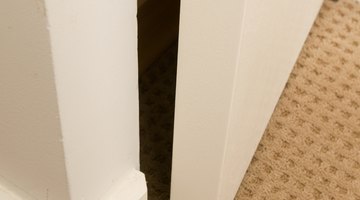DIY How to Refinish Luan Doors
Luan doors are typically used in home interiors for closets and other non-essential doorways because they are relatively inexpensive and lightweight, making them easily replaceable. However, it is possible to refinish a luan door to extends its lifespan.

Things You Will Need
- Screwdriver
- Varnish stripper or mineral spirits
- Clean cloths
- Scrub brush
- Plastic putty knife
- 120- to 200-grit sandpaper
- Paintbrush
- Paint roller
- Paint sprayer
- Polyurethane
- Foam or lamb's wool applicator
Unlike refinishing a solid hardwood door, you can't use power tools, such as a handheld sander, to strip the old finish because it may damage the luan. This will make the project take a bit longer than refinishing hardwood surfaces.
-
Take the door out of its frame by removing the screws in the hinges. Remove the door knob and any other hardware. Bring the door to an open, well-ventilated workspace and lay it flat across a table.
-
Strip the finish using a solvent, such as varnish stripper or mineral spirits. When refinishing a luan door, it is best to use solvents instead of just sanding down the finish as you might do with a solid hardwood door. Apply the solvent to a cloth, then wipe the solvent into the door.
-
Apply more solvent as necessary to completely coat the door. Allow the solvent to soak into the wood for about 10 minutes. Wipe the wood with a damp cloth to remove the finish. If the finish doesn't come off easily with the cloth, use a scrub brush or a plastic putty knife.
-
Wipe the wood down with a damp cloth once you have stripped the finish. Allow the door to dry. Sand the wood lightly with medium to fine grade sandpaper, between 120- and 200-grit. Do this by hand to avoid damaging the wood. Sand just until the wood is bare, then wipe the door with a damp cloth.
-
Apply stain to the door with a paintbrush, paint roller, paint sprayer or a cotton cloth. Use whichever tool you are most comfortable with. Work with the grain of the wood.
-
Allow the stain to soak into the wood for about five minutes, then wipe the door down with a clean cloth to absorb any excess stain. Allow the door to dry, then flip the door over and repeat the process for the other side of the door. When staining either side of the door, spread the stain along the edges of the door.
-
Seal the door with a protective sealant, such polyurethane. Pour the polyurethane on the door, then spread it with a foam or lamb's wool applicator — this type of tool won't leave brush marks. Slide the applicator along the grain of the wood slowly without applying too much pressure.
-
Allow the polyurethane to dry, then flip the door and repeat the process for the other side. When sealing either side of the door, coat the edges of the door with sealant. Coat the door with one or two more layers of polyurethane and let it dry completely before placing it back in the frame and reinstalling the knob.
Warning
When using polyurethane, protect yourself with gloves, goggles and a face mask.
References
Warnings
- When using polyurethane, protect yourself with gloves, goggles and a face mask.
Writer Bio
Jarrett Melendez is a journalist, playwright and novelist who has been writing for more than seven years. His first published work was a play titled, "Oh, Grow Up!" which he wrote and performed with a group of his classmates in 2002.
Photo Credits
- Jupiterimages/Photos.com/Getty Images
- Jupiterimages/Photos.com/Getty Images
More Articles



